|
2. Economizing
Scarce Resources
View Entire Chapter 2
Print one-page
chapter
2 review
A. Factors of Production
|
Factor |
Definition |
Income |
|
Land |
Anything fixed (natural resources) |
Rent |
|
Labor |
Physical and mental talents |
Wages |
|
Capital |
Something physical to aid production (factories, computers, an
educated/trained labor force) |
Interest |
|
Enterprise |
Initiative, risk taking, innovation |
Profit |
B. The Production Possibility Frontier
(Curve)
measures how many of two types of goods can
be produced.
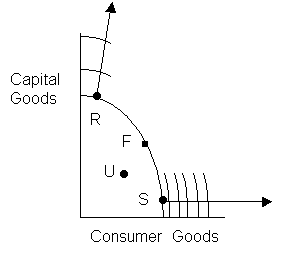 1.
Static Model (time is
constant, inputs are fixed) 1.
Static Model (time is
constant, inputs are fixed)
a. Consumer goods such
as televisions, pizzas, and social security bring current
satisfaction.
b. Capital goods such as
machinery, tractors, and improved technology increase
future productive capabilities.
c. Point F on the
production possibility frontier represents full employment of all resources
(100% efficiency).
d. Point U represents
unemployment of some economic resources.
e. Having more capital
goods requires giving up some consumer goods.
f. Applies to individuals
as you can invest by building a deck or going to school or you can go on an
expensive vacation.
g. How society and
individuals answer these economic questions is explored in chapters five and
six.
2.
Dynamic Model
(time is not constant,
inputs like factors and technology are not fixed, growth indicated by, arrows
occur
a. As inputs increase, growth
occurs and the curve shifts right.
b. Point S represents slow
growth due to high consumption.
c. Point R represents rapid
growth due to high capital investment.
d. Economic and political
system chosen and run by a society determines the location and movement of
these variables
3.Opportunity costs
a. The cost of Item A measured in
terms of what must be foregone of Item B.
b. When considering doing A, we
consider the highest valued alternative as limited resources means we can't afford
both.
c. For more information visit
the
Production Possibilities Curve from Wikipedia.
d. Politicians seldom talk of the
opportunity cost of what they plan to do.
e. Examples
1.
The opportunity cost of good grades is the value which could have been received by
spending time with family and friends.
2.
The opportunity costs of more capital goods is the value
which could have been received from having more consumer
goods.
4.
Law of increasing opportunity costs
a. Opportunity costs usually increase.
1. To have one unit of
Item A you must give up amount X of Item B. To have a
second unit of Item A you must give up more than amount X
of Item B.
2.
Primary reason for increasing costs is resources are not perfect substitutes.
3. Examples
a)
Training more people in math and science would increase productivity
for a while but eventually people would be trained to be
engineers who would be more productive as managers, teachers, or
entertainers etc.
b) Gains from replacing people with machines may be large at
first but eventually machines would be used to do
what people can do
more efficiently.
c. When
opportunity costs are not increasing, the production possibility
curve is a straight line.
High tech investment may even bend the
curve the other way and have decreasing cost, but not forever!
b. Below
is an example of the trade-off
between investing people in high tech industries versus entertainment
industries.
Alternative Production Possibilities for10 entertainers and no
technicians'.
Units of Production
High tech
0 1
2 3 4
Entertainment
10 9 7
4 0
Cost of an
additional unit of high tech production
1 2
3 4
measured in terms
of entertainment given up
Example
Adam Sandler, a great entertainer, probably would not of been a
great computer programmer,
though his
dad Stan was an electrical engineer, his sister Elizabeth a dentist,
and his brother a Scott a lawyer.
Adam might be the
first resource to move to create more production.
3.
Characteristics of Market System
Capitalism Review
View
Entire Chapter 3
Print one-page
chapter 2
review
A. Economic systems determine what to produce, how to produce,
and who will receive production.
B. An economic system must also adapt to changing economic environments.
For example, America
must adapt to changes to September 11?
C. Adam
Smith described the beginning of capitalism.
1. His book,
The Wealth of Nations,
was the first description of capitalism.
2. Published in 1776, it described capitalism as it was practiced in 18th
century England.
D. Basic characteristics described by Adam Smith
1. Private property-the right to own resources and bequeath property
2. Freedom of enterprise-own
a business
3. Freedom of economic choice-work/not work, spend/not
spend
4. Role of self-interest
a. People are by nature economic creatures
b. Self-interest is a fundamental characteristic of people
5. Competitive market system
a. Many buyers and sellers
b.
Market participants, buyers and sellers, have little control over price
c. Competition performs the organizing and controlling
functions for a market economy
6. Limited government
("Laissez-faire
")
a. Government
should let
markets be with a hands-off philosophy)
b. Acceptable
government involvement has become an important political question in the
United
States during the last few decades.
E. Modern Capitalism has additional features
1. Complex Market System Setting Prices
2. Importance of Capital Goods and
Technology
3. Specialized
a.
Complexity
requires company produce limit their product lines
b. Division of
Labor allows specialization by ability ad training.
F.
Creative Destruction
described by 20th century
sociologist/economist
Joseph Schumpeter
was an important addition
to the idea of
capitalism.
1. Change involves the creation of improved economic
structures based on technology and the
destruction of inefficient economic structures.
2. Capitalism allows this
destruction to take place.
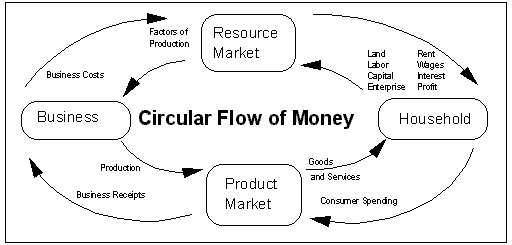
G. Economic Systems
A. Pure capitalism as described by Adam Smith
never existed.
B. Recent economic systems have
are Mixed Economies
(a mixture of Capitalism
and Socialism)
1. Socialism
emphasizes collective ownership and management of economic resources that are equally distributed.
2. Democratic
Socialism, as practiced in Western Europe, has public ownership of key industries such as transportation and
communication
a. The economic systems of Europe began moving away from socialism toward capitalism in the late 1970's
b. Margaret
Thatcher, former prime minister of England, started this trend.
c. Ronald Reagan
agreed and stressed the market system during his presidency
(1981-89).
3. Communism
is the
ideal of those practicing a "Marxian system."
a. Named after 19th century philosopher
Karl Marx
b. The public owns almost all wealth which is centrally managed, i.e., a
planned economy
c.
Presidential
Courage explores how Ronald Reagan deplored Communism.
C. Traditional
economy, where customs determines the economy activity, is practiced by many developing countries.
4. Demand
and Supply Review View
Entire Chapter 4
Print one-page
chapter 4
review
A. A market is defined
as an institution or mechanism which promotes trade
by bringing together buyers (demanders) and sellers
(suppliers).
1. Replaced barter which is the direct exchange of
goods.
2 Modern market brings money and prices into the
circular flow of goods.
B. Demand is willingness to buy.
1. Demand is a
schedule of the amounts of goods and services consumers
are willing and able to buy at a set of prices.
2. Total demand is the Horizontal
Summation of
individual demand.
3. Law of demand:: price
and quantity are inversely related and as price goes up,
quantity demanded goes down and vice versa
4. Why more is bought as price drops.
a. Income
Effect: as price drops, consumers feel richer and buy more.
b. Substitution
Effect: as price drops, it becomes cheaper relative to
other goods and consumers buy more
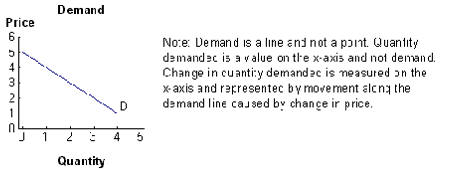
C. What determines demand
1.
Tastes
or preferences of consumers
2.
Number of consumers
3.
Incomes of consumers
a.
normal (superior)
goods
such as steak and vacations - more is purchased as income
increases.
b
inferior
goods such as bread and hamburger
- less is purchased as
income increases.
4.
Consumer expectations
5.
Price of related goods
a.
Substitutes
are goods that compete with each other such as hot dogs
and hamburgers.
If the price of a good increases, the demand for its substitutes will increase.
b.
Complements
are goods that are purchased together like
hot dogs and rolls.
If the price of a good
increases, the demand for its
complement will decrease.
5.
''Ceteris
Paribus''
is Latin for all other variables remain the
same. So we change one variable at a tome.
D. Changes (shifts) in Demand
1. A decrease in demand shifts the demand curve to the left
2. An increase in demand shifts the demand curve to
the right
E. Supply is willingness to sell
1. Supply is a schedule of the amounts of
goods or services producers are willing and
able to sell at a set of prices.
2. Law of supply:
price and quantity supplied are directly related because price and
expected
profit are directly related
a.
As price goes up, quantity supplied goes up
b.
As price goes down, quantity supplied goes down
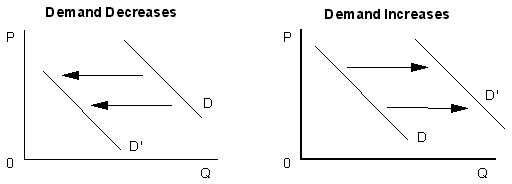
F. What determines supply
1. Product costs
as affected by technology, resource prices, government involvement with taxes
and subsidies
2. Price of related goods
a. If 2
goods are substitutes, price up for one will increase supply of the other (price of gasoline up,
supply of alternative
fuels increases) as
companies see more potential profit
b. If 2
goods are complements, price down of one will increase supply of other (price of PC's
down,
supply of computer software up) as the
expected increase in sales of the first item should increase
sales of the
complement.
3. Number of producer
and their expectations concerning the
above listed variables will affect supply
G. Changes (shifts) in supply
1. A decrease in supply shifts the
supply curve to the left
2. An increase in supply shifts the
supply curve to the right
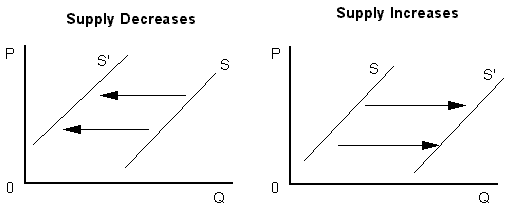
H. Equilibrium is where suppliers and demanders agree
on price and quantity as depicted
by E.
1. If the price is too high, a surplus results
and price must be lowered
2. If the price is too low, a shortage results.
This happens with toys every Christmas
(Cabbage Patch Dolls)
3. If they can not agree, as happened with
Beta videotape machines,
then the curves do not intersect
and the goods are not sold.
4. Rationing function of price
makes for an efficient allocation of resources.
When competitive forces of supply and demand result in an
equilibrium, a
rationing function of
goods produce to
consumers has occurred.
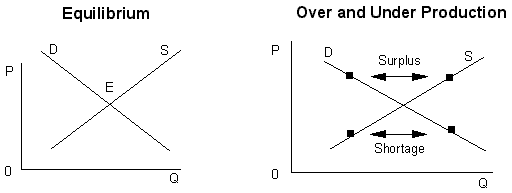
I. How changes in supply and demand affect equilibrium price and quantity6


J. Government Imposed Price Ceilings and Floors
1. A price ceiling keeps prices from rising (rent
control) helping renters but often
resulting in a
shortage of housing as
investors seek higher returns elsewhere.
2. A price floor keeps prices
from falling (farm price supports)
helps farmers
though a surplus often results as more of supported crops are
produced.
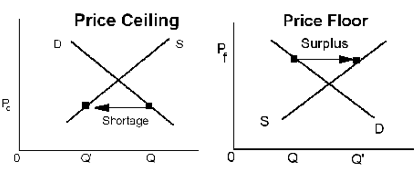
V. 5 Key Questions Society Must Answer Review
View Entire Chapter 5
Print one-page
chapter 5
review
A. What to produce?
1. Which goods
a.
Those that can be sold at a profit, consumers vote with dollars
b.
Accounting
Profit: The amount by which total revenue exceeds
accounting costs (rents,
wages, and interest)
c.
Normal
Profit
1. Amount received for enterprise
2. Considered by economists to be a cost
d. Economic
Profit
1.
The amount by which total revenues exceed all "Factor" costs.
2. Some
think of it as a surplus.
3.
Expanding industries have economic profit.
a) Bill Gates, founder of Microsoft, has earned many billions
of dollars.
b) So has Sam Walton of Wal-Mart
2. How many goods
a.
Level of demand and efficiency of supply determine output.
b.
Society determines total demand (who works, how often and
for how many years).
c.
Success of economic system determines efficiency of supply.
B. How to produce?
1. Companies must be competitive
2. Competition is the "Invisible
Hand" assuring
a. High quality
goods are produced.
b. Efficient
production methods are employed.
c. Prices and profits are reasonable.
d. For more
read
Adam Smith and the invisible hand
by Helen Joyce
of
Plus magazine.
3. Technology and innovation are
instrumental to success.
C. Who will receive production?
1. Those willing and able to
pay
2. Function of income, savings,
and attitude toward debt financing
D. How will the economy adapt to changing environments?
1. Today's economic
environment is changing more rapidly because
of the communication
revolution.
2. Magnitude of these changes is similar to
that which occurred in the
last quarter of the 19th century.
3. Companies and individuals must "adapt or be
gone."
4. Capitalism allows creative destruction to
work.
5. Recently technology has changed rapidly and people
are being
adversely affected
a. Normally, political forces
would attempt to slow creative destruction.
b. But, the 1990's was the
decade of free enterprise so creative
destructions moved on.
c. Perhaps the next recession
will slow down the free market
revolution.
E. Market system evaluated
1. Advantages are resources allocated efficiently,
economic freedoms (enterprise,
choice)
2. Disadvantages
a. Too
dependent upon competition eroded by monopoly power resulting in waste
and inefficiency
result because of monopoly power exercised by business,
unions, governments, and interest groups.
b.
Inequitable distribution of income (economic survival of
the fittest)
c. Market
failure occurs
1. Not
all costs (pollution) and benefits (public health) are properly accounted
for.
2. Why?
because measuring their cost and benefits in dollars is difficult and
subjective.
d.
Political process sometimes interferes with creative destruction.
VI.
Government's Economic Function
Entire Chapter 6
Print one-page
chapter 6
review
A. Provide
a proper legal atmosphere (rules) for capitalism
B. Insure competition
1. Antitrust laws
protect against abuse of monopoly power.
2. Natural
(justifiable) monopolies such as AT&T were allowed because
duplicating high-cost fixed investments is illogical.
3. The emphasis on free markets discussed
in chapter 3 has resulted in some natural
monopolies being broken into smaller companies which had to
compete against
new companies touting new technologies.
C. Provide for an equitable distribution of income
1. Transfer
payments where a government moves general revenue to a
specific group, i.e., Aid to Families with Dependent Children,
students...
2. Market Intervention
(affecting supply and demand)
a.
Minimum wage decreases supply raising price and lowering quantity.
b. Excise
taxes on alcohol, cigarettes, jewelry, etc., deceases supply.
c. Farm
price supports, aid to small business and education increases supply.
D. Adjust for market failures
1. Adjust for spillovers
(externalities)
a. Effects of a market
system often spillover onto non-participants who are
external to the market
transaction.
b.
Both costs and benefits result.
1. Pollution hurts (costs) society so government tries to affect
the supply of,
and demand for, pollution causing products such as automobiles.
For automobiles, they lower supply by requiring catalytic converters and
they
lower demand with high excise taxes.
2. An educated workforce benefits society so government increases demand
(aid to
students) and supply (aid to colleges).
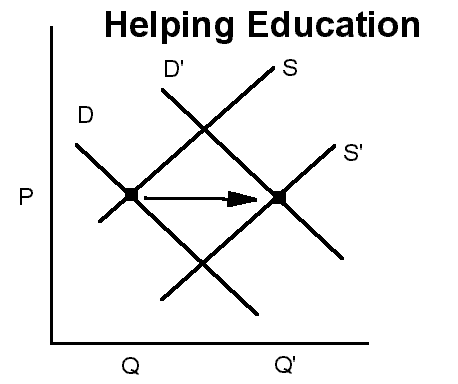 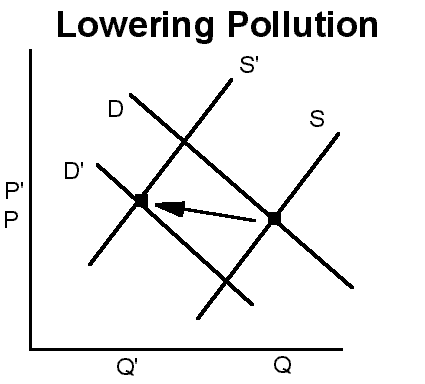
|